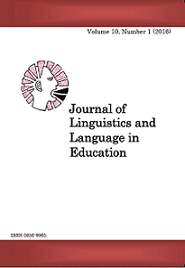Journal of Linguistics and Language in Education Volume 13
Abstract
Abstract
It is increasingly recognized that most minority language speakers tend to give
up their languages in favour of a vehicular language as they move to urban
centres.In recent years, the degree of endangerment of indigenous languages
seems to be accelerating due to the increased dominance of Fulfulde.Thisstudy
seeksto find out whether theseeming progressiveabandonment of local
languagesin the Far North region of Cameroon isdue to Fulfulde or French.
Data wasobtained through participant observation and questionnaire
administration. The resultsindicate that Fulfulde, and to a certain extent
French tend to monopolize most of the proposed domains of language use. The
findings show that the respondents have limited fluency in theirMother
Tongues. Theyalso reveal that Fulfulde is gradually becoming participants '
Mother Tongues, and they considereditas a potential threat to minority
languages. It concludesthat minority languages arethreatened more by
Fulfulde than French in Maroua.
References
References
Adrianto, A. S. (2015). Study of Slang Word in "Ride Along" Movie.
Unpublished Master ' s Dissertation, the State Islamic
University Maulana Malik Ibrahim Malang.
Agha, A. (1999). Register. Journal of Linguistic Anthropology, 9(2).
€“219.
Ainiala, T. (2012). Place Names and Identities: The Uses of Names of
Helsinki. In B. Helleland, C. E. Ore & S. Wikstrøm (eds.).
Names and Identities: Oslo Studies in Language 4(2): 7 €“15.
Agha, A. (2015). Tropes of Slang. Signs and Society, 3(2): 306 €“330.
Al-Kharabasheh, A. & Yassin, O. (2017). Translation of
Colloquialisms in the Arabic-into-English Subtitled Film, The
Dupes. International Journal of Comparative Literature &
Translation Studies, 5(3): 18 €“27.
Arua, E. & Alimi, M. M. (2009). The Creation of Students' Academic
Slang Expressions in the University of Botswana. Linguistic
Online, 40(4): 15 €“28.
Dozie, C. P. & Madu, L. I. (2012). Language of Communication
among University Students in Nigeria: A Study on Slangy
Expressions in Federal University of Technology Owerri,
Nigeria. Journal of Communication, 3(2): 99 €“103.
Eble, C. (2009). Slang and the Internet. New Challenges in Language
and Literature. FALE/UFMG: 81 €“95.
El Falaky, M. S. (2016). Yes We Are: A Sociolinguistic Study of
Egyptian Slang. International Journal of Language and
Literature, 4(2): 75 €“84.
Fisher, D. & Lapp, D. (2013). Learning to Talk like the Test: Guiding
Speakers of African American Vernacular English. Journal of
Adolescent & Adult Literacy, 56(8): 634 €“648.
Forsskåhl, M. (2001). Girls ' Slang and Boys ' Slang: Two Towns in
Finland Visited. Nora: Nordic Journal of Women's Studies,
(2): 98 €“106.
Giles, H. & Ogay, T. (2007). Communication Accommodation Theory.
In B. B. Whaley & W. Samter (eds.). Explaining
communication: Contemporary Theories and Exemplars.
Mahwah, NJ, US: Lawrence Erlbaum Associates Publishers:
€“310.
Gomaa, Y. A. (2015). Saudi Youth Slang Innovations: A
Sociolinguistic Approach. International Journal of Linguistics
and Communication, 3(2): 98 €“112.
Kariuki, A. Kanana, F. E. & Kebeya, H. (2015). The Growth and Use
of Sheng in Advertisements in Selected Businesses in Kenya.
Journal of African Cultural Studies, 27(2): 229 €“246.
Kothari, C. R. (2004). Research Methodologies: Methods and
Techniques. New Delhi: New International Age (P) Ltd.
Lewadowski, M. (2010). Sociolects and Registers: A Contrastive
Analysis of two Kinds of Linguistic Variation. Linguistics
Research, 20: 60 €“79.
Liaw, J. O. Dani, N. A. & Johari, A. Z. (2013). Language Usage of
Jargon and Slang in Strategic Studies. Australian Journal of
Basic and Applied Sciences, 7(4): 661 €“666.
Mazer, J. P. & Hunt, S. K. (2008). The Effects of Instructor Use of
Positive and Negative Slang on Student Motivation, Affective
Learning, and Classroom Climate. Communication Research
Reports, 25(1): 44 €“55.
Mutonya, M. (2008). Swahili Advertising in Nairobi: Innovation and
Language Shift. Journal of African Cultural Studies, 20(1): 3 €“
Pedersen, T. (2009). The Use of Slang in British English?: A Study of
the Slang Used in Football Factory and Little Britain.
Unpublished Master ' s Dissertation, The University of Kalmar.
Saal, E. O. (2010). The Persuasive Effect of Teenager Slang in Print-
based HIV Messages. Unpublished PhD Dissertation,
Radboud University.
Wijaya, B. S. (2013). The Use of English Slang Words in Informal
Communication among 8th Semester Students of English
Department in Binus University. Humaniora, 5(1): 197 €“209.
Yaghan, M. A. (2008). "Arabizi": A Contemporary Style of Arabic
Slang. Design Issues, 24(2): 39 €“52.
Yule, G. (2010). The Study of Language (3rd Edition). Cambridge:
Cambridge University Press.
Zhou, Y. & Fan, Y. (2013). A Sociolinguistic Study of American
Slang. Theory and Practice in Language Studies, 3(12): 2209 €“
Published
Issue
Section
License
Copyright © by Department of Foreign Languages and Linguistics, University of Dar es Salaam
All rights reserved. No part of this publication may be reproduced or transmitted in any form or by any means, electronic or mechanical, including photocopying, recording, or any information storage or retrieval system, without permission in writing from the publisher, except for short extracts in fair dealing, for research or private study, critical scholarly review or discourse with an acknowledgement.



